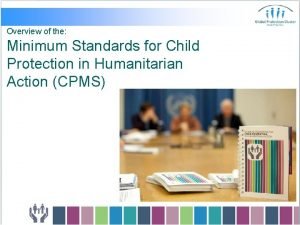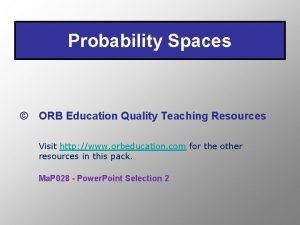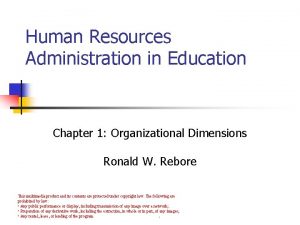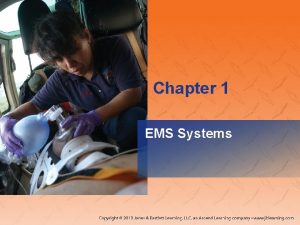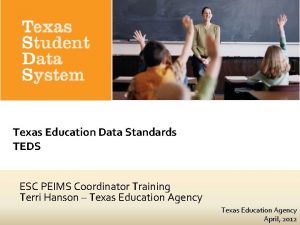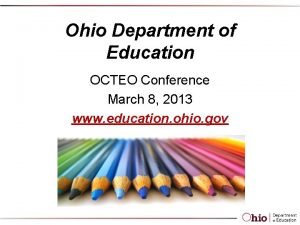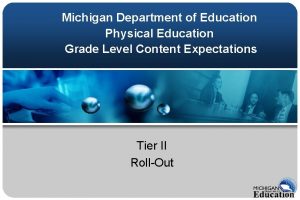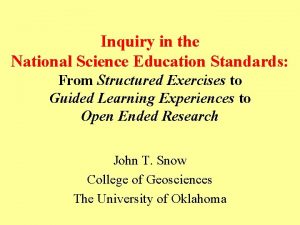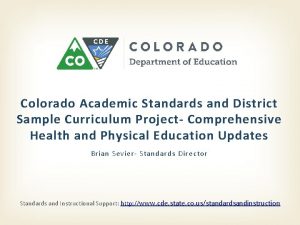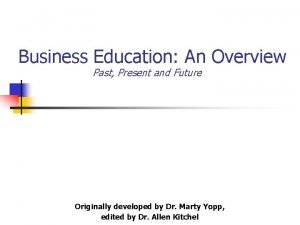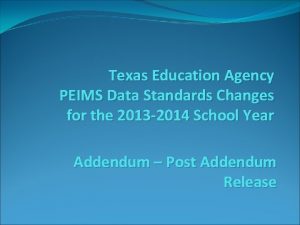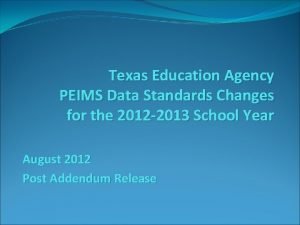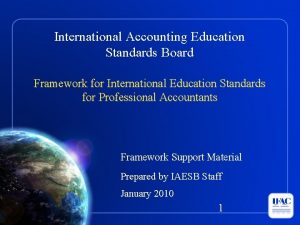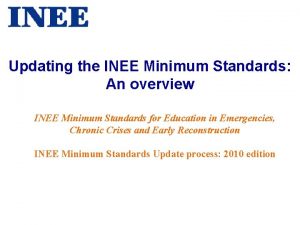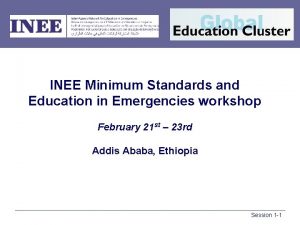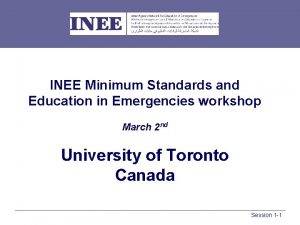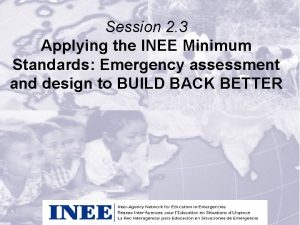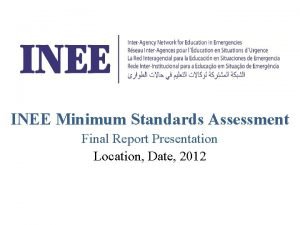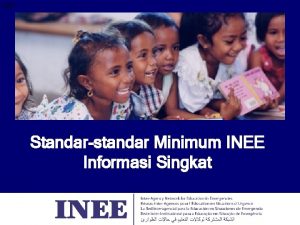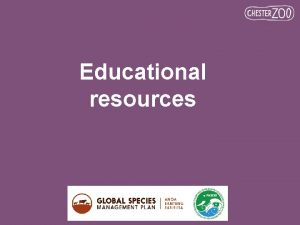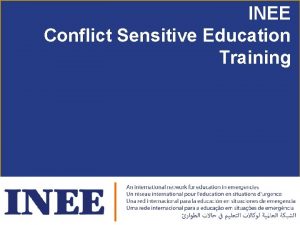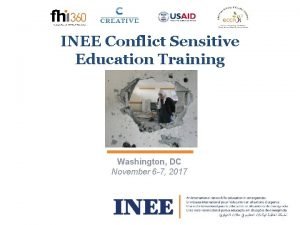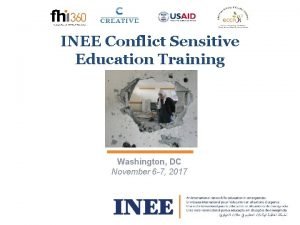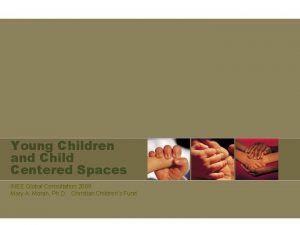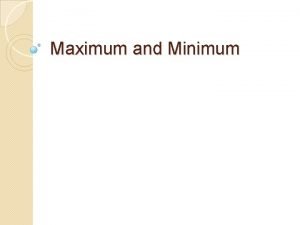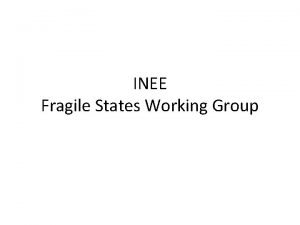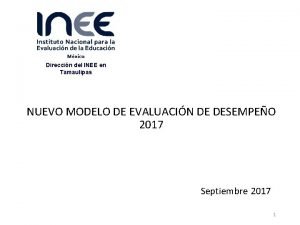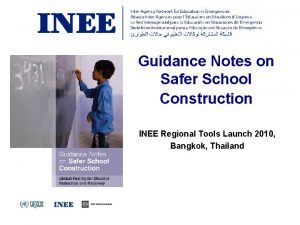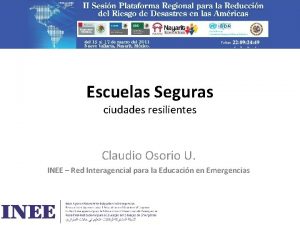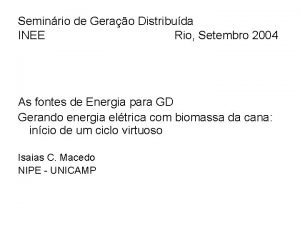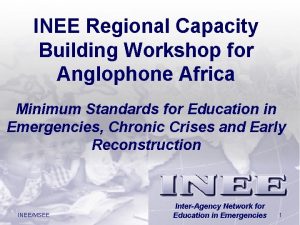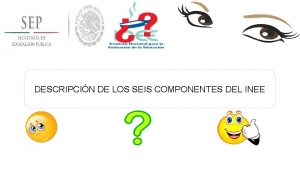INEE Minimum Standards and Resources for Education in





























































































- Slides: 93

INEE Minimum Standards and Resources for Education in Emergencies Workshop February 27 th, 2012 Nairobi, Kenya

Administration § Introductions § Materials –INEE Minimum Standards handbook and toolkits § Agenda § Restrooms § Lunch / breaks § Guidelines/expectations for the next 2 days INEE and Global Education Cluster

Workshop Objectives § Be familiar with the INEE Minimum Standards and tools § Understand the relevance and value added of the INEE MS to the Somalia context § Identify how to use the INEE Minimum Standards and tools to strengthen the work of the Somalia Education Cluster § Identify and commit to applying the INEE Minimum Standards to your work INEE and Global Education Cluster

The Impact of Emergencies and the Rationale for Education in Emergencies

Learning Objectives At the end of this session, participants will: § Identify the different types of emergency scenarios and describe their impact on children, education systems and communities. § Explain the rationale for education as a first response in emergencies § Be aware of the key international legal instruments and conventions and understand that they underpin learner’s right to education in emergencies INEE and Global Education Cluster

INEE and Global Education Cluster

Definition of Emergency UNDMTP (United Nations Disaster Management Training Programme) “A disaster is a serious disruption of the functioning of a society, causing widespread human, material, or environmental losses which exceed the ability of affected society to cope using only its own resources. Disasters are often classified according to their speed of onset (sudden or slow), or according to their cause (natural or human-made). ” INEE and Global Education Cluster

Types of Emergency § Natural disasters which include hurricanes, earthquakes, tsunamis, droughts, cyclones, epidemics, floods, landslides and volcanoes § Man-made disasters, including civil or military unrest, war, occupation, economic crises § Complex emergencies, which combine both natural and man-made emergencies. INEE and Global Education Cluster

Rapid onset Types of Emergencies earthquake volcano flood epidemic cyclone Slow onset terrorist attack chemical plane crash spill war drought Natural famine civil unrest Manmade INEE and Global Education Cluster

Common Elements § § Affects people Triggered by a hazard Directly related to vulnerability Exceeds capacity of household, community or group of people to cope § Social processes play an important role § More to do with society than natural phenomena INEE and Global Education Cluster

Hazards, Risks and Vulnerabilities Hazard A physical or human-made event that can potentially trigger a disaster (e. g. earthquakes, mud-slides, floods, volcanic eruptions, tsunamis, drought, economic collapse, and war) Vulnerability The susceptibility of people and things to be damaged by a hazard. A person or group’s vulnerability therefore depends on their capacity to anticipate, cope with, resist and recover from the impact of a hazard. INEE and Global Education Cluster

Risk The likelihood of a disaster happening to a particular group of people - can be estimated by frequency and severity of a hazard when combined with vulnerability and capacity of people to meet that hazard. Risk can therefore be expressed as: Risk = Hazard x Vulnerability INEE and Global Education Cluster

The Impact of Emergencies INEE and Global Education Cluster

Protracted crisis Characterized by recurrent natural disasters and/or conflict, longevity of food crises, breakdown of livelihoods, insufficient institutional capacity to react to the crises and higher levels of dependence on humanitarian aid. This requires special attention! Session 1 -14

Protracted crisis Session 1 -15

Protracted crisis are often a result of complex emergencies but countries affected are not heterogeneous. For example; §Afghanistan §Zimbabwe §Democratic People’s Republic of Korea §Haiti §Somalia Session 1 -16

Impacts of protracted crisis § Aid dependence § Food insecurity (mal-nutrition and undernourishment) § Unpredictable trend line to the emergency and changing realities § Undermines state apparatus § Often forces people to make significant adjustments to their livelihoods § Displacement and accelerated rural – urban migration Session 1 -17

Brainstorming What have been the impacts in Somalia generally and what have been the impacts on learners specifically? Session 1 -18

Response challenges in protracted crisis § Disruption of capacity building § Difficulties for monitoring and evaluation § May include protracted displacement (IDP and refugee children and adolescents) § Efforts tend to be focused on maintaining a certain status of response and support as opposed to shifting into recovery, reconstruction and more positive growth § Other localized acute emergencies can occur during protracted emergencies. Session 1 -19

Consequences for Children § Children and youth neglected, vulnerable to harm and exploitation § Psychosocial impacts exacerbated by lack of safe spaces and opportunities to be with their peers § Cognitive and developmental needs neglected § Likelihood of engaging in unsafe activities increases § Likelihood of dropping out of school increases § Children and youth may be more vulnerable to recruitment by armed groups or armed forces. Session 1 -20

Vulnerable groups In an emergency marginalisation often increases. Who are the vulnerable groups in Somalia? Session 1 -21

What is the Impact on Marginalised Groups? In an emergency marginalisation often increases. Marginalised groups include: § Children with disabilities § Children living in rural areas § Orphans § Street children § Ex-combatants § Child labourers § Ethnic minorities § HIV/AIDS affected § Can be gender based INEE and Global Education Cluster

Need for Education in Emergencies INEE and Global Education Cluster

Definition of Education in Emergencies “The provision of quality education opportunities that meet the physical protection, psychosocial, developmental and cognitive needs of people affected by emergencies, which can be both lifesustaining and life-saving “ INEE and Global Education Cluster

Consequences for Children § Children and youth neglected, vulnerable to harm and exploitation § Psychosocial impacts exacerbated by lack of safe spaces and opportunities to be with their peers § Cognitive and developmental needs neglected § Likelihood of engaging in unsafe activities increases § Likelihood of dropping out of school increases § Children and youth may be more vulnerable to recruitment by armed groups or armed forces. INEE and Global Education Cluster

Education is an important first response because education: § Is a fundamental right to all and in emergencies children and other learners are often denied this right § Is critical for healthy development § Can help children and youth deal with the effects of crisis situations § Can help create a sense of normalcy for children and communities § Is critical to provide protection in a safe environment and provide life saving and sustaining skills and support § Is an important means of promoting tolerance and conflict resolution § Is critical for economic recovery and social reconstruction INEE and Global Education Cluster

Education is an important first response because education: § Can engender democratic participation and respect for rights § Is what children and parents prioritise § Is a platform for providing life saving knowledge and skills (landmines, cholera, gender violence, trafficking) § Reduces maternal and child mortality § Can identify and reach children with special needs § Can provide nutrition § Provides an opportunity to get out-of-school children enrolled § Can support livelihoods and income generation activities INEE and Global Education Cluster

Framework for Education in Emergencies INEE Minimum Standards for Education

Learning Objectives At the end of this session, participants will: § Understand what is the Inter-Agency Network for Education in Emergencies (INEE). § Understand the Domains and Standards of the Minimum Standards for Education: Preparedness, Response, Recovery. § Understand how the Minimum Standards can be applied to ensure quality education provision. INEE and Global Education Cluster

Conceptual Framework for Phases of Emergency Preparedness, Mitigation, Prevention • Before the Emergency Longer-term Recovery Critical Response • 18 months and onwards • 1 week to 6 months Early Recovery • 6 to 18 months Session 1 -30

Phases of Emergency: the reality § Rarely sequential § Rarely discrete (complicated by other intersecting issues). § Emergency phases overlap and recur Instead, we need to think of this as a three dimensional model where the phases may be overlapping Session 1 -31

Before an emergency: Preparedness, Mitigation and Prevention Timeframe Phase Description Before the emergency. Preparedness, Mitigation, Prevention Continuous cycle of planning and organizing to prevent, protect against, respond to, recover from, and mitigate against natural disasters and conflict. From 1 week to 6 months after the emergency Critical Response -Addresses immediate education needs of children and families (i. e. temporary learning spaces, non-formal education, recreation, play, psychosocial support until formal education is ready to re-start) From 6 months 6 to 18 months after the response Early Recovery - Transition from immediate needs to longer-term needs. From 18 months onwards Long Term Recovery and Regular Programming - Transition to longer-term development programming and connection to preparedness, mitigation and prevention Session 1 -32

Inter-Agency Network for Education in Emergencies (INEE) § Open, global network of UN agencies, NGOs, donors, practitioners, researchers and individuals from affected populations (5, 700 members) § Working to ensure right to education in emergencies § Sharing good practices, tools and research § Encouraging information sharing among members and partners § INEE’s 10 th year Anniversary www. ineesite. org Session 1 -33

The Sphere Project § A process that began in 1997 to address concerns of quality and accountability in humanitarian responses § Humanitarian Charter that emphasizes the “right to life with dignity” § Sphere Minimum Standards in Humanitarian Response q Water, sanitation and hygiene promotion q Food security, nutrition and food aid q Shelter, settlement and non-food items q Health services www. sphereproject. org Session 1 -34

Goal of the INEE Minimum Standards § Common starting point to reach a minimum level of educational quality and access § Tool to improve coordination and enhance accountability and predictability § Tool for capacity-development and training § Aid to strengthen the resilience of Ministries of Education § Tool to promote education/advocacy Session 1 -35

Development of the INEE Minimum Standards Consultative process § INEE listserv consultations § Field-based consultations § Peer review process Content of handbook represents rights, lessons learned, and collective thinking of education professionals More than 2, 250 people participated (2003 -2004) Session 1 -36

Update of the INEE Minimum Standards (2009 -2010) • Updated through a highly consultative process—more than 1, 300 people in 52 countries: § reflect recent developments in the field of Education in Emergencies § incorporate the experience and good practices of the users of the Handbook § make the Handbook more userfriendly Session 1 -37

Minimum standards assessment (2011 -2012) § What is the value added of the use and application of the INEE MS? § Surveys, interviews and focus groups § Results out in April / May 2012 Session 1 -38

The INEE MSE and other education frameworks § Which legal instruments and international agreements support the concept of the INEE Minimum Standards? § What are the education rights inherent in these legal instruments and international agreements? § How do the INEE MS relate to the context of Somalia? Session 1 -39

Why “minimum” standards? § They articulate a universal minimum level of educational quality, access and provision. § They reflect the legal instruments upon which they are based, which allow for appropriate education for all even in situations of emergency § If cannot attain standards/indicators, must understand explain gap and what needs to change Session 1 -40

Overview of the INEE Minimum Standards § INEE was established to develop standards to promote a minimum level of access to quality education for all persons including those affected by emergencies § The standards are based on the Convention on the Rights of the Child (CRC), Education for All (EFA) and Humanitarian Charter to represent ‘universal goals for helping adults and children achieve the right to life with dignity’. § Addition to Sphere Humanitarian Standards which does not include education. § More information: INEE web site at www. ineesite. org. INEE and Global Education Cluster

The 5 Domains INEE and Global Education Cluster

11 Cross-Cutting Issues § Conflict Mitigation § Disaster Risk Reduction § Early Childhood Development § Gender § HIV and AIDS § Human Rights § Inclusive Education § Inter-sectoral linkages § Protection § Psychosocial support § Youth INEE and Global Education Cluster

Standards, Key Actions, Guidance Notes § Standards - are what you want to reach. They are qualitative and universal, applicable in any environment. § Key Actions - are suggested actions to be taken in order to reach/meet the standard. § Guidance Notes – cover points of good practice to consider when applying the minimum standards and adapting the key actions in different situations. INEE and Global Education Cluster

Foundational Domain: Community Participation § Standard 1: Participation Community members participate actively, transparently and without discrimination in analysis, planning, design, implementation, monitoring and evaluation of education responses. § Standard 2: Resources Community resources are identified, mobilised and used to implement age-appropriate learning opportunities. INEE and Global Education Cluster

Foundational Domain: Coordination § Standard 1: Coordination mechanisms for education are in place and support stakeholders working to ensure access to and continuity of quality education. INEE and Global Education Cluster

Foundational Domain: Analysis § Standard 1: Assessment Timely education assessments of the emergency situation are conducted in a holistic, transparent and participatory manner. § Standard 2: Response Strategies Inclusive education response strategies include a clear description of the context, barriers to the right to education and strategies to overcome those barriers. § Standard 3: Monitoring Regular monitoring of education response activities and the evolving learning needs of the affected population is carried out. § Standard 4: Evaluation Systematic and impartial evaluations improve education response activities and enhance accountability. INEE and Global Education Cluster

Access and Learning Environment Domain: Access and Learning Environment § Standard 1: Equal Access All individuals have access to quality and relevant education opportunities. § Standard 2: Protection and Well-being Learning environments are secure and safe, and promote the psychosocial well-being of learners, teachers and other education personnel. § Standard 3: Facilities and Services Education facilities promote the safety and well-being of learners, teachers and other education personnel and are linked to health, nutrition, psychosocial and protection services. INEE and Global Education Cluster

Teaching and Learning Domain: Teaching and Learning § Standard 1: Curricula Culturally, socially and linguistically relevant curricula are used to provide formal and non-formal education, appropriate to the particular context and needs of learners. § Standard 2: Training, Professional Development and Support Teachers and other education personnel receive periodic, relevant and structured training according to needs and circumstances. § Standard 3: Instruction and Learning Processes Instruction and learning processes are learner-centred, participatory and inclusive. § Standard 4: Assessment and Learning Outcomes Appropriate methods are used to evaluate and validate learning outcomes. INEE and Global Education Cluster

Teachers and Other Education Personnel Domain: Teachers and Other Education Personnel § Standard 1: Recruitment and Selection A sufficient number of appropriately qualified teachers and other education personnel are recruited through a participatory and transparent process, based on selection criteria reflecting diversity and equity. § Standard 2: Conditions of Work Teachers and other education personnel have clearly defined conditions of work and are appropriately compensated. § Standard 3: Support and Supervision Support and supervision mechanisms for teachers and other education personnel function effectively. INEE and Global Education Cluster

Domain: Education Policy § Standard 1: Law and Policy Formulation Education authorities prioritise continuity and recovery of quality education, including free and inclusive access to schooling. § Standard 2: Planning and Implementation Education activities take into account international and national education policies, laws, standards and plans and the learning needs of affected populations. INEE and Global Education Cluster

Exercise Applying the INEE Minimum Standards to a Case Study INEE and Global Education Cluster

Exercise Directions 1. Five groups of 5 or 6 people. Each group will analyse the case study based on of the 5 domains. 2. Group Work Tasks: a) Read the case study. b) Identify which standards were used in the emergency education response in the assigned category c) Identify which standards could have been used in the response. 3. Gallery Walk (20 minutes) INEE and Global Education Cluster

INEE Guidance Notes on Teaching and Learning

Learning Objectives At the end of this session, participants will: • Understand how the Guidance Notes on Teaching and Learning serve as a complementary tool to the INEE Minimum Standards; • Be familiar with the Guidance Notes on Teaching and Learning, including the inter-relatedness of the four standards; • Be able to navigate the tool for given scenarios and your own working context. INEE and Global Education Cluster

What are the Guidance Notes on Teaching and Learning? § Resource/tool § Give best practice guidance § Provide guidance on processes through key questions § Expansion on INEE MS Domain on Teaching and Learning INEE and Global Education Cluster

How to Use the Guidance Notes on Teaching and Learning § Planning/Design of Teaching and Learning Programmes § A Guide to implementation § Monitoring & Evaluation § Practical tips for classroom practice § Highlight “best practice” § Advocacy INEE and Global Education Cluster

The Consultative Process Geneva, Switzerland Ramallah, Palestine Boston, USA New York, USA Washington DC, USA Phnom Penh, Cambodia Koboko, Uganda Kampala, Uganda Dar es Salaam, Tanzania Harare, Zimbabwe INEE and Global Education Cluster

Overview of the INEE Guidance Notes on Teaching and Learning and Resource Pack § INEE members asked for practical, in-depth guidance on the teaching and learning domain. § >300 people developed the Guidance Notes on Teaching and Learning. INEE and Global Education Cluster

Nothing Stands Alone INEE and Global Education Cluster

11 Key Thematic Issues Throughout ü Conflict Mitigation ü Inclusive Education ü Disaster Risk Reduction ü ü Early Childhood ü Development ü ü Gender ü ü HIV and AIDS Intersectoral linkages Protection Psychosocial support Youth ü Human Rights INEE and Global Education Cluster

Guidance Notes on Teaching & Learning INEE and Global Education Cluster

Each chapter looks at 5 areas: INEE and Global Education Cluster

Each section provides key points to consider…. § Key questions listed § Organized around the Emergency-Chronic Crisis. Early Recovery continuum. INEE and Global Education Cluster

Example of the Key Points to Consider Table EMERGENCY EARLY RECOVERY & PREPAREDNESS CHRONIC CRISIS EXAMPLE CATEGORY: STAKEHOLDERS EXAMPLE QUESTION: Are the most appropriate stakeholders involved in implementing or supporting curricula dissemination and continued assessment of the relevance of the content? (see Note J, page 15) EXAMPLE QUESTION: Who is responsible for longer-term support for curricula dissemination and coordination with other sections? (see Note J, page 15) INEE and Global Education Cluster

Curricula INEE and Global Education Cluster

Curricula Standard 1: Curricula Culturally, socially and linguistically relevant curricula are used to provide formal and non-formal education, appropriate to the particular context and needs of learners. INEE and Global Education Cluster

Curricula Standard 1: Analysis Curriculum Review & Analysis KEY POINTS TO CONSIDER: § Who coordinates and conducts curriculum review and analysis? § How should the review and analysis of curriculum be conducted? § What should be the focus of the curriculum analysis? § What do learners need? § What existing curriculum and teaching and learning materials are available? INEE and Global Education Cluster

Curricula Standard 1: Programme Design Curriculum Adaptation & Development KEY POINTS TO CONSIDER: § Who is involved in the adaptation and development of the curriculum? § How are immediate education goals reflected in the curriculum? How can these be adapted at different stages to transition into longer-term education goals? § Which key thematic issues should be taken into consideration when adapting and developing curriculum? § How is the curriculum process coordinated with other initiatives and sectors? INEE and Global Education Cluster

Curricula Standard 1: Implementation KEY POINTS TO CONSIDER: § Who should be involved in both formal and temporary modification or creation of learning materials? § What kinds of learning materials are most appropriate for the context? § What systems are in place for the feedback and evaluation of revised curriculum? INEE and Global Education Cluster

Curricula Standard 1: Monitoring & Evaluation § Provides examples of how to approach the monitoring and evaluation of both the process and content. For example: q Have the appropriate stakeholders been involved? -- process q Have efforts to link with teacher orientation and training been successful? -- content INEE and Global Education Cluster

Curricula Standard 1: Additional Resources § Provides additional information on Curricula, including steps required to assess and establish appropriate programming, as well as general reference and advocacy materials. § All available to download: http: //www. ineesite. org/index. php/post/resource_p ack/ INEE and Global Education Cluster

Training, Professional Development and Support INEE and Global Education Cluster

Training, Professional Development and Support Standard 2: Training, Professional Development and Support Teachers and other education personnel receive periodic, relevant and structured training according to needs and circumstances. INEE and Global Education Cluster

Training, Professional Development and Support Standard 2: Analysis KEY POINTS TO CONSIDER: § Who should be involved in assessing the needs and capacities of teachers based on the context and changing educational needs? § Who are the teachers? § How are different methodologies taught and promoted through teacher training programmes? INEE and Global Education Cluster

Training, Professional Development and Support Standard 2: Programme Design Content & Methodology KEY POINTS TO CONSIDER: § How is the content of teacher training programmes determined? § Do current teacher training programmes promote inclusive and supportive learning environments? § How are different methodologies taught and promoted through teacher training programmes? § Do the content and methodology of teacher training programes support longer-term educational goals? INEE and Global Education Cluster

Training, Professional Development and Support Standard 2: Implementation Supervision KEY POINTS TO CONSIDER: § Who is available and has the capacity to provide support at the classroom and school level? § What systems and staff are in place to ensure continued support to teachers at classroom and school levels? INEE and Global Education Cluster

Training, Professional Development and Support Standard 2: Monitoring & Evaluation § Provides examples of how to approach the monitoring and evaluation of both the process and content. For example: q Who has been involved and have they had both the legitimacy and authority to have optimal impact? -- process q Do the materials and approaches enable teacher to effectively teach learners in the established curriculum and create an inclusive learning environment? -- content INEE and Global Education Cluster

Training, Professional Development and Support Standard 2: Additional Resources § Provides additional information on Training, Professional Development and Support including steps required to assess and establish appropriate programming, as well as general reference and advocacy materials. § All available to download: http: //www. ineesite. org/index. php/post/resource_p ack/ INEE and Global Education Cluster

Activity: Quality Education Discussion and thinking on the meaning of Quality Education in Emergencies INEE and Global Education Cluster

Questions for Group Discussion: § Under which of the four standards under the Domain of Teaching and Learning would you place this photo? § What elements of the photos represent (or don’t represent) education quality in emergencies, chronic crisis, early recovery and preparedness? § What are the main barriers to the provision of Quality Education and what can you or your organization do to ensure that the most vulnerable and the marginalized are included, even prioritized, in education response? INEE and Global Education Cluster

INEE and Global Education Cluster

INEE and Global Education Cluster

INEE and Global Education Cluster

INEE and Global Education Cluster

INEE and Global Education Cluster

INEE and Global Education Cluster

INEE and Global Education Cluster

INEE and Global Education Cluster

INEE and Global Education Cluster

INEE and Global Education Cluster

Quality Education for Prevention, Preparedness, Response and Recovery § Quality education: Quality education is accessible, gendersensitive and responds to diversity. It includes 1) a safe and inclusive learner friendly environment; 2) competent and welltrained teachers who are knowledgeable in the subject matter and pedagogy; 3) an appropriate context-specific curriculum that is comprehensible and culturally, linguistically and socially relevant for the learners; 4) adequate and relevant materials for teaching and learning; 5) participatory methods of instruction that respect the dignity of the learner; 6) appropriate class sizes and teacher- student ratios; and 7) an emphasis on recreation, play, sport and creative activities, in addition to areas such as literacy, numeracy and life skills so learners are able to improve not only their cognitive skills, but also prevent a cycle of anger and human destructiveness at a social and generational level. INEE and Global Education Cluster

Conclusion § Whether in a chronic crises, acute emergency, early recovery, or preparedness phase of a conflict or natural disaster, the Guidance Notes on Teaching and Learning: q Inform decision-making regarding the nature of formal or non-formal education services to be provided q Guide curricula decisions, education priorities, and teaching and learning methodologies INEE and Global Education Cluster
 Local maximum and minimum
Local maximum and minimum Minimum standards practice test
Minimum standards practice test Child protection minimum standards
Child protection minimum standards What is transformation process
What is transformation process Fixed resources definition
Fixed resources definition Factors necessary for service standards are
Factors necessary for service standards are Renewable resources vs nonrenewable resources
Renewable resources vs nonrenewable resources Fspos vägledning för kontinuitetshantering
Fspos vägledning för kontinuitetshantering Typiska drag för en novell
Typiska drag för en novell Nationell inriktning för artificiell intelligens
Nationell inriktning för artificiell intelligens Vad står k.r.å.k.a.n för
Vad står k.r.å.k.a.n för Varför kallas perioden 1918-1939 för mellankrigstiden
Varför kallas perioden 1918-1939 för mellankrigstiden En lathund för arbete med kontinuitetshantering
En lathund för arbete med kontinuitetshantering Underlag för särskild löneskatt på pensionskostnader
Underlag för särskild löneskatt på pensionskostnader Tidbok för yrkesförare
Tidbok för yrkesförare Sura för anatom
Sura för anatom Vad är densitet
Vad är densitet Datorkunskap för nybörjare
Datorkunskap för nybörjare Stig kerman
Stig kerman Hur skriver man en tes
Hur skriver man en tes Delegerande ledarskap
Delegerande ledarskap Nyckelkompetenser för livslångt lärande
Nyckelkompetenser för livslångt lärande Påbyggnader för flakfordon
Påbyggnader för flakfordon Lufttryck formel
Lufttryck formel Offentlig förvaltning
Offentlig förvaltning Jag har gått inunder stjärnor text
Jag har gått inunder stjärnor text Presentera för publik crossboss
Presentera för publik crossboss Jiddisch
Jiddisch Kanaans land
Kanaans land Treserva lathund
Treserva lathund Luftstrupen för medicinare
Luftstrupen för medicinare Bästa kameran för astrofoto
Bästa kameran för astrofoto Cks
Cks Programskede byggprocessen
Programskede byggprocessen Mat för unga idrottare
Mat för unga idrottare Verktyg för automatisering av utbetalningar
Verktyg för automatisering av utbetalningar Rutin för avvikelsehantering
Rutin för avvikelsehantering Smärtskolan kunskap för livet
Smärtskolan kunskap för livet Ministerstyre för och nackdelar
Ministerstyre för och nackdelar Tack för att ni har lyssnat
Tack för att ni har lyssnat Referatmarkering
Referatmarkering Redogör för vad psykologi är
Redogör för vad psykologi är Borstål, egenskaper
Borstål, egenskaper Atmosfr
Atmosfr Borra hål för knoppar
Borra hål för knoppar Orubbliga rättigheter
Orubbliga rättigheter Fr formel
Fr formel Tack för att ni har lyssnat
Tack för att ni har lyssnat Steg för steg rita
Steg för steg rita Verksamhetsanalys exempel
Verksamhetsanalys exempel Tobinskatten för och nackdelar
Tobinskatten för och nackdelar Toppslätskivling effekt
Toppslätskivling effekt Handledning reflektionsmodellen
Handledning reflektionsmodellen Egg för emanuel
Egg för emanuel Elektronik för barn
Elektronik för barn Plagg i rom
Plagg i rom Strategi för svensk viltförvaltning
Strategi för svensk viltförvaltning Kung som dog 1611
Kung som dog 1611 Ellika andolf
Ellika andolf Sju för caesar
Sju för caesar Tack för att ni lyssnade
Tack för att ni lyssnade Större och mindre tecken
Större och mindre tecken Texter som rimmar
Texter som rimmar Inköpsprocessen steg för steg
Inköpsprocessen steg för steg Rådet för byggkompetens
Rådet för byggkompetens Etik och ledarskap etisk kod för chefer
Etik och ledarskap etisk kod för chefer Exspektans eller expektans
Exspektans eller expektans Myndigheten för delaktighet
Myndigheten för delaktighet Trög för kemist
Trög för kemist Sju principer för tillitsbaserad styrning
Sju principer för tillitsbaserad styrning Läkarutlåtande för livränta
Läkarutlåtande för livränta Karttecken brant
Karttecken brant Ramsa geometriska former
Ramsa geometriska former Shivaismen
Shivaismen Var finns arvsanlagen
Var finns arvsanlagen Bris för vuxna
Bris för vuxna Big brother rösta
Big brother rösta Orb education quality teaching resources
Orb education quality teaching resources Human resources in education sector
Human resources in education sector Human resources administration in education
Human resources administration in education Maximum mode of 8086
Maximum mode of 8086 National ems education standards
National ems education standards Teds esc
Teds esc Ohio tpes
Ohio tpes Michigan grade level content expectations
Michigan grade level content expectations National science education standards inquiry
National science education standards inquiry Colorado physical education standards
Colorado physical education standards Future of business education
Future of business education Oklahoma state department of education math standards
Oklahoma state department of education math standards Texas education data standards
Texas education data standards Performance standards examples education
Performance standards examples education Peims data standards code table c022
Peims data standards code table c022 California state standards physical education
California state standards physical education International accounting education standards board
International accounting education standards board


